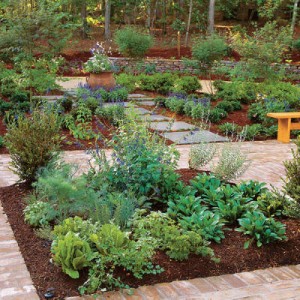





The Herb Garden
A herb garden is not strictly a habitat and is not usually planted with wildlife in mind, but many common herbs are excellent plants in this respect, being rich in nectar and so attracting bees, butterflies, hoverflies and other insects.
Thyme and winter savory will be alive with bees throughout the summer, whereas lavender and marjoram also attract bees and many lovely butterflies.
Angelica and fennel play host to many insects, and the seed-eating birds relish angelica seeds in the autumn. Almost all herbs attract wildlife of some sort or another, so every garden should have its patch.
 Herbs are useful plants that people have enjoyed for over 3,000 years. Their benefits are not confined simply to flavouring food, although for many of us that is their main use: they are also used to preserve food, to enhance the atmosphere and cloak noxious smells, to prepare cosmetics and to treat the sick.
Herbs are useful plants that people have enjoyed for over 3,000 years. Their benefits are not confined simply to flavouring food, although for many of us that is their main use: they are also used to preserve food, to enhance the atmosphere and cloak noxious smells, to prepare cosmetics and to treat the sick.
Many common herbs were cultivated by the ancient Romans, and although not strictly native plants they have long been naturalized. Herbs contain essential oils within the cells of their leaves, stems and flowers, and it is these that give them their therapeutic value and flavour. Unlike scented flowers, however, the aroma is not always readily detectable, and in some herbs the leaves need to be chopped, crushed or cooked for the scent to emerge.
When planning a herb garden it is important to realize that herbs are grown together because it is convenient for the grower to have them all in one place. This does not mean that they all enjoy the same growing conditions and will happily thrive together in the same bed. In fact some, like rosemary, lavender and thyme, need a dry, sunny site, others, such as mint and Levisticum officinale (lovage), prefer a moist fertile soil, and others are happy in shade or partial shade, like angelica and Myrrhis odorata (sweet cicely).
To try to accommodate these different requirements, a herb garden is frequently divided into several beds, which allows some areas to have added compost and manure to keep the soil moist and fertile, whereas other areas are left unfed (a well-drained, neutral to slightly alkaline soil is the preferred home for many herbs).
Positioning the garden by the house has many benefits: the herbs can be readily picked for use, the bees can be viewed easily, and if you choose a site where the house wall shades part of the plot there will be both partially shaded beds and others in full sun. A 2m (6ft) square can contain all the herbs you are likely to need. Choose a dry day in mid to late spring to plant your herb garden.
A group of terracotta pots filled with fragrant, healthy herbs is a pleasure to see, and the different growing requirements of many herbs make it sensible to grow them in containers: the soil and drainage can be adjusted to suit each occupant and the containers can be placed in sun or shade according to each plant’s preference. The pots can be placed near the house for ease of access and so that any visiting wildlife can be viewed from the windows.
Two further advantages to growing herbs in pots are that rampant plants like mint, which could otherwise take over a plot, can be constrained, and that any herb that has been harvested and now needs time to rebuild its strength can be placed out of the way until it recovers.

Copyright © www.100flowers.win Botanic Garden All Rights Reserved